Cefixime dosages: 100 mg
Cefixime packs: 10 pills, 20 pills, 30 pills, 60 pills, 120 pills, 180 pills
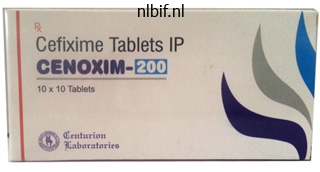
Generic cefixime 100 mg on line
Cathelicidins Polypeptides produced by neutrophils and various barrier epithelia that serve various features in innate immunity antibiotic resistance zone of inhibition order cefixime 100 mg online, including direct toxicity to microorganisms infection outbreak generic cefixime 100 mg, activation of leukocytes should you take antibiotics for sinus infection cefixime 100mg with visa, and neutralization of lipopolysaccharide antibiotics for acne review order 100 mg cefixime otc. Central tolerance A type of self-tolerance induced in generative (central) lymphoid organs as a consequence of immature self-reactive lymphocytes recognizing self antigens and subsequently resulting in their demise or inactivation. Central tolerance prevents the emergence of lymphocytes with high-affinity receptors for the self antigens that are expressed in the bone marrow or thymus. Centrocytes B cells within the gentle zone of germinal centers of secondary lymphoid organs, that are the progeny of proliferating centroblasts of the dark zone. Centrocytes that categorical high-affinity Ig are positively chosen to survive and bear isotype switching and additional differentiation into long-lived plasma cells and reminiscence B cells. This approach has been successful in effectively treating several sorts of broadly metastatic cancers which would possibly be unresponsive to different therapies. Patients 494 Glossary show lowered resistance to infection with pyogenic bacteria. Chemokine receptors Cell surface receptors for chemokines that transduce alerts stimulating the migration of leukocytes. There are no less than 19 different mammalian chemokine receptors, every of which binds a special set of chemokines; all are members of the seven-transmembrane -helical, G protein�coupled receptor family. Chemokines A giant household of structurally homologous low�molecular-weight cytokines that stimulate leukocyte chemotaxis, regulate the migration of leukocytes from the blood to tissues by activating leukocyte integrins, and preserve the spatial organization of different subsets of lymphocytes and antigen-presenting cells inside lymphoid organs. The motion of leukocytes within numerous tissues is often directed by gradients of low�molecular-weight cytokines referred to as chemokines. When T cells are engineered to specific chimeric antigen receptors these cells can recognize and kill cells that the extracellular domain acknowledges. Chromosomal translocation A chromosomal abnormality by which a segment of one chromosome is transferred to another. The illness is characterized by recurrent intracellular bacterial and fungal infections, typically accompanied by persistent cell-mediated immune responses and the formation of granulomas. Chronic rejection A form of allograft rejection characterised by fibrosis with loss of regular organ buildings occurring throughout a prolonged interval. In many instances, the most important pathologic event in persistent rejection is graft arterial occlusion brought on by proliferation of intimal easy muscle cells, which is called graft arteriosclerosis. The classical pathway is initiated by binding of antigen-antibody complexes to the C1 molecule, leading to proteolytic cleavage of C4 and C2 proteins to generate the classical pathway C3 convertase. The classical pathway, as nicely as the choice and lectin pathways, terminates with formation of the membrane assault complex. Clonal anergy A state of antigen unresponsiveness of a clone of T lymphocytes experimentally induced by recognition of antigen within the absence of additional indicators (costimulatory signals) required for practical activation. Clonal anergy is taken into account a model for one mechanism of tolerance to self antigens and could also be applicable to B lymphocytes as well. Clonal deletion A mechanism of lymphocyte tolerance in which an immature T cell in the thymus or an immature B cell within the bone marrow undergoes apoptotic death as a consequence of recognizing a self antigen. Clonal enlargement the roughly 1000- to 100,000fold improve in number of lymphocytes specific for an antigen that results from antigen stimulation and proliferation of naive T and B cells. Clonal growth happens in lymphoid tissues and is required to generate enough antigen-specific effector T lymphocytes and plasma cells from uncommon naive precursors to eradicate infections. Clonal ignorance A form of lymphocyte unresponsiveness by which self antigens are ignored by the immune system even though lymphocytes particular for these antigens remain viable and practical. Clonal selection speculation A basic tenet of the immune system (no longer a hypothesis) stating Glossary 495 that each individual possesses quite a few clonally derived lymphocytes, every clone having arisen from a single precursor, expresses one antigen receptor, and is able to recognizing and responding to a distinct antigenic determinant. Clone A group of cells, all derived from a single widespread precursor, which keep most of the genotypic and phenotypic options shared by the cell of origin. Coinhibitor A cell floor protein expressed by antigenpresenting cells or tissue cells that binds to coinhibitory receptors on effector T cells, inducing alerts that block T cell activation by antigen and costimulators. Collectins play a task in the innate immune system by appearing as microbial pattern recognition receptors, and so they might activate the complement system by binding to C1q. Complement A system of serum and cell floor proteins that work together with each other and with different molecules of the immune system to generate essential effectors of innate and adaptive immune responses. The classical, different, and lectin pathways of the complement system are activated by antigen-antibody complexes, microbial surfaces, and plasma lectins binding to microbes, respectively, and consist of a cascade of proteolytic enzymes that generate inflammatory mediators and opsonins. These hypervariable segments assume loop buildings that collectively kind a surface complementary to the three-dimensional structure of the bound antigen. Congenital immunodeficiency A genetic defect during which an inherited deficiency in some aspect of the innate or adaptive immune system leads to an elevated susceptibility to infections.
Order cefixime 100mg amex
These cells have thick protoplasmic extensions that bulge into the lumen of the terminal bronchioles infection by fingernail generic cefixime 100mg amex. They may have secretory features that contribute to the extracellular liquid lining the bronchioles and alveoli virus morphology buy 100 mg cefixime otc. Terminal bronchiole tree Terminal bronchiole Alveoli Canals of Lambert chapter 1 the Anatomy and Physiology of the Respiratory System 39 Bronchial Cross-Sectional Area the entire cross-sectional space of the tracheobronchial tree steadily will increase from the trachea to the terminal bronchioles bacteria zinc effective cefixime 100mg. The total cross-sectional area will increase significantly beyond the terminal bronchioles due to the numerous branches that happen at this level 0x0000007b virus cefixime 100 mg on line. Air flows down the tracheobronchial tree as a mass to concerning the degree of the terminal bronchioles, like water flowing by way of a tube. Because the cross-sectional area becomes so great past this point, however, the forward motion basically stops and the molecular motion of gasoline turns into the dominant mechanism of ventilation. The arteries come up from the aorta and follow the tracheobronchial tree so far as the terminal bronchioles. Beyond the terminal bronchioles, the bronchial arteries lose their identity and merge with the pulmonary arteries and capillaries, which are a part of the pulmonary vascular system. The normal bronchial arterial blood flow is about 1 percent of the cardiac output. In addition to the tracheobronchial tree, the bronchial arteries nourish the mediastinal lymph nodes, the pulmonary nerves, a portion of the esophagus, and the visceral pleura. About one-third of the bronchial venous blood returns to the proper atrium by way of the azygos, hemiazygos, and intercostal veins. Most of this blood comes from the primary two or three generations of the tracheobronchial tree. The remaining two-thirds of the bronchial venous blood drains into the pulmonary circulation, through bronchopulmonary anastomoses, after which flows to the left atrium by means of the pulmonary veins. Note the fast increase in the whole cross-sectional space of the airways within the respiratory zone. The mixing of venous blood and freshly oxygenated blood is named venous admixture. The respiratory bronchioles are characterized by alveoli budding from their partitions. The walls of the alveolar ducts that arise from the respiratory bronchioles are fully composed of alveoli separated by septal partitions that contain smooth-muscle fibers. In the lungs of the grownup male, there are roughly 300 million alveoli between 75 and 300 m in diameter, and small pulmonary capillaries cowl about eighty five to ninety five % of the alveoli. This association provides an average surface area of 70 m2 (about the size of a tennis court) out there for gas change. Collectively, the respiratory bronchioles, alveolar ducts, and alveolar clusters that originate from a single terminal bronchiole are referred to as a primary lobule. Synonyms for major lobule include acinus, terminal respiratory unit, lung parenchyma, and functional units (see Table 1�1). The formation of the pores might embody forty two Section one the Cardiopulmonary System-The Essentials a number of of the following processes: (1) the desquamation. Diseases involving the lung parenchyma accelerate the formation of alveolar pores of Kohn, and the quantity and measurement of the pores increase progressively with age. Macrophages are believed to originate from stem cell precursors in the bone marrow. Then, as monocytes, they presumably migrate by way of the bloodstream to the lungs, where they transfer about or are embedded within the extracellular lining of the alveolar floor. The interstitium is a gel-like substance composed of hyaluronic acid molecules that are held together by a weblike network of collagen fibers. The tight space is the area between the alveolar epithelium and the endothelium of the pulmonary capillaries-the area the place most gas change occurs. The unfastened house is primarily the realm that surrounds the bronchioles, respiratory bronchioles, alveolar ducts, and alveolar sacs. Water content on this space can increase greater than 30 % before a significant stress change develops. The area across the respiratory bronchioles, alveolar ducts, and alveolar sacs is called the loose house.
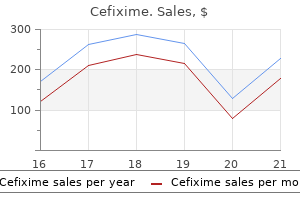
Order cefixime 100mg free shipping
Dectins Pattern recognition receptors expressed on dendritic cells that recognize fungal cell wall carbohydrates and induce signaling occasions that promote inflammation and enhance adaptive immune responses bacteria klebsiella infections order cefixime 100mg. Defensins Cysteine-rich peptides produced by epithelial barrier cells within the pores and skin antibiotic resistance characteristics cheap cefixime 100mg online, intestine antibiotics cream trusted cefixime 100 mg, lung antibiotics that start with z trusted 100mg cefixime, and other tissues and in neutrophil granules that act as broad-spectrum antibiotics to kill a extensive variety of micro organism and fungi. Dendritic cells Bone marrow�derived cells found in epithelial and lymphoid tissues which are morphologically characterized by skinny membranous projections. Immature (resting) classical dendritic cells are important for induction of tolerance to self antigens. Plasmacytoid dendritic cells produce plentiful kind 1 interferons in response to exposure to viruses. Desensitization A method of treating immediate hypersensitivity disease (allergies) that includes repetitive administration of low doses of an antigen to which people are allergic. Determinant the particular portion of a macromolecular antigen to which an antibody or T cell receptor binds. DiGeorge syndrome A selective T cell deficiency brought on by a congenital malformation that ends in faulty improvement of the thymus, parathyroid glands, and other structures that arise from the third and fourth pharyngeal pouches. Direct presentation is partly responsible for sturdy T cell responses to allografts. Diversity the existence of numerous lymphocytes with different antigenic specificities in any individual. Random use of D segments contributes to the range of the antigen receptor repertoire. Ectoparasites Parasites that live on the floor of an animal, corresponding to ticks and mites. Both the innate and adaptive immune methods may play a job in protection towards ectoparasites, often by destroying the larval phases of those organisms. Effector cells the cells that perform effector capabilities throughout an immune response, corresponding to secreting cytokines. Effector part the phase of an immune response by which a international antigen is destroyed or inactivated. For instance, in a humoral immune response, the effector part may be characterised by antibodydependent complement activation and phagocytosis of antibody- and complement-opsonized bacteria. Endosome An intracellular membrane-bound vesicle into which extracellular proteins are internalized throughout antigen processing. Endotoxin contains both lipid elements and carbohydrate (polysaccharide) moieties. In cells of the immune system, enhancers are liable for integrating cell surface indicators that lead to induced transcription of genes encoding lots of the effector proteins of an immune response, similar to cytokines. Eosinophils are necessary in protection towards extracellular parasites, together with helminths. Epitope the precise portion of a macromolecular antigen to which an antibody or T cell receptor binds. Epitope spreading In autoimmunity, the development of immune responses to a number of epitopes as an autoimmune illness originally focusing on one epitope progresses, probably brought on by additional breakdown in tolerance and release of additional tissue antigens as a outcome of the inflammatory course of stimulated by the preliminary response. Fab (fragment, antigen-binding) A a half of an antibody, first produced by proteolysis of IgG, that features one complete light chain paired with one heavy chain fragment containing the variable domain and solely the first constant area. Therefore, Fab preparations are used in research and therapeutic functions when antigen binding is desired with out activation of effector features. They are used in research and therapeutic purposes when antigen binding is desired without antibody effector capabilities. The death pathway is initiated when Fas binds to Fas ligand expressed on activated T cells. Fas-mediated killing of lymphocytes is important for the upkeep of self-tolerance. Fas ligand binds to the dying receptor Fas, thereby stimulating a signaling pathway leading to apoptotic cell death of the Fas-expressing cell. Fc (fragment, crystalline) A region of an antibody molecule that could be isolated by proteolysis of IgG that incorporates only the disulfide-linked carboxyl-terminal areas of the two heavy chains. The Fc area of Ig molecules mediates effector features by binding to cell surface receptors or the C1q complement protein. Fc receptors are sometimes multichain protein complexes that embody signaling parts and Ig-binding components.
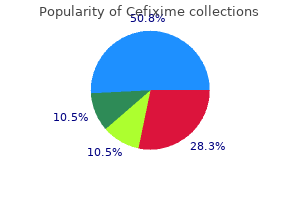
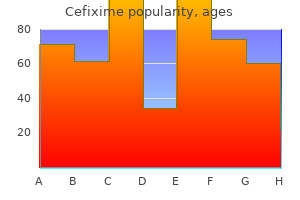
Order 100mg cefixime overnight delivery
The amino-terminal extracellular portion of the chain includes two Ig-like domains that kind the binding site for IgE bacteria that causes strep throat discount 100 mg cefixime free shipping. The two identical chain polypeptides are linked by a disulfide bond and are homologous to the chain of the T cell antigen receptor complicated (see Chapter 7) antibiotics for sinus infection during first trimester quality cefixime 100mg. Therefore antibiotics used to treat mrsa generic cefixime 100 mg on-line, no single antigen will cross-link sufficient of the IgE molecules to cause mast cell activation infection 2 hacked discount 100 mg cefixime fast delivery. Activation of mast cells leads to three types of biologic response: secretion of preformed granule contents by exocytosis (degranulation), synthesis and secretion of lipid mediators, and synthesis and secretion of cytokines. Lyn and Syk are tyrosine kinases that bind to the and chains and participate in signaling events. Exposure to the antigen will cross-link enough IgE molecules to trigger mast cell activation. Other stimuli, including the complement fragment C5a, also can activate mast cells. A photomicrograph of a resting mast cell with plentiful purplestaining cytoplasmic granules is proven in C. These granules are additionally seen in the electron micrograph of a resting mast cell proven in E. In distinction, the depleted granules of an activated mast cell are proven within the photomicrograph (D) and electron micrograph (F). In resting mast cells, these enzymes inhibit mast cell granule membrane fusion with the plasma membrane. Following membrane fusion, the contents of the mast cell granules are released into the extracellular environment. The biologic actions of the granule contents released upon mast cell degranulation are described later. Cytokine secretion by activated mast cells is a consequence of newly induced cytokine gene transcription. The biochemical events that regulate cytokine gene transcription in mast cells seem to be similar to the events that occur in T cells. The complement fragments C3a and C5a can cause mast cell degranulation, and this is why they had been named anaphylatoxins. Other stimuli induce selective activation of mast cells to produce arachidonic acid metabolites, cytokines, and chemokines, but not degranulation. These further modes of mast cell activation could also be important in non�immune-mediated quick hypersensitivity reactions, or they could amplify IgE-mediated reactions. Furthermore, inflammatory responses initiated in a mast cell�independent method as part of the early innate response to infection or tissue damage could additionally be amplified when the cytokines, chemokines, and complement fragments produced act on local mast cells. Many neuropeptides, together with substance P, somatostatin, and vasoactive intestinal peptide, induce mast cell histamine release and may mediate neuroendocrinelinked mast cell activation. The nervous system is understood to modulate instant hypersensitivity reactions, and neuropeptides may be involved on this impact. Mast cell degranulation can additionally be stimulated by many alternative cationic substances, collectively called secretagogues. These include endogenous inflammatory peptides, medicine known to cause antagonistic allergy-like reactions, and the compounds 48/80 and mastoparan used experimentally as pharmacologic triggers for mast cells. Mast cells also categorical Fc receptors for IgG heavy chains, and the cells may be activated by cross-linking sure IgG. However, IgE is the major antibody isotype concerned in most immediate hypersensitivity reactions. Such variations in activation and mediator release may account for variable scientific shows. Mast cells and basophil mediators embrace vasoactive amines and enzymes stored preformed in granules, as well as cytokines and lipid mediators, that are largely newly synthesized on cell activation. The biogenic amines and lipid mediators induce vascular leakage, bronchoconstriction, and intestinal hypermotility, all components of the quick response.
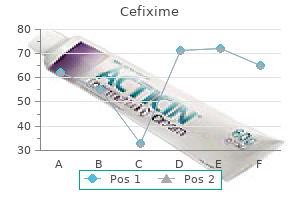
100 mg cefixime visa
The base of the guts is broad and flat bacteria model cefixime 100mg discount, about 9 cm antimicrobial effects of silver nanoparticles safe cefixime 100 mg, and factors toward the best shoulder antibiotic resistance cases discount cefixime 100mg on line. When fingers are pressed between the fifth and sixth ribs slightly below the left nipple antibiotics jobs generic 100mg cefixime with visa, the center beat may be felt the place the apex is in touch with the internal chest wall. The outer wall, the fibrous pericardium, is a tough, dense, connective tissue layer. Its major function is to (1) defend the guts; (2) anchor the heart to surrounding buildings, such because the diaphragm and the nice vessels; and (3) forestall the center from overfilling. The serous pericardium is composed of two layers: the parietal layer, which lines the interior surface of the fibrous pericardium, and the visceral layer (also referred to as the epicardium). The epicardium is an integral a part of the center typically described as the outermost layer of the heart. Pericarditis can lead to extreme fluid accumulation inside the pericardial sac-a cardiac tamponade (see Clinical Connection 5�4: Cardiac Tamponade). Inflammation Clinical Connection 5-4 Cardiac Tamponade A cardiac tamponade (also referred to as cardiac compression or pericardial tamponade) is a possible medical emergency in which a large volume of fluid or blood collects within the pericardial sac. Causes of a cardiac tamponade embody trauma, rupture of the heart wall following a myocardial infarction, rupture of blood vessels caused by a malignant tumor, and radiation remedy. Treatment consists of the insertion of a needle into the pericardial cavity and a syringe to drain the fluid. The epicardium, or visceral layer of the pericardium, is composed of a single sheet of squamous epithelial cells overlying delicate connective tissue. The myocardium is a thick contractile middle layer of uniquely constructed and arranged muscle cells. The contractile tissue of the myocardium is composed of fibers with the attribute cross-striations of muscular tissue. These interlacing round bundles successfully connect all the parts of the heart collectively. Collectively, the spiral bundles form a dense community known as the fibrous skeleton of the heart, which reinforces the internal portion of the myocardium. Specifically, modified tissue fibers of the myocardium represent the conduction system of the center. The endocardium is a glistening white sheet of squamous epithelium that rests on a skinny connective tissue layer. It is steady with the endothelium of the nice blood vessels-the superior and inferior vena cava. Cardiac muscle bundles Blood Supply of the Heart Arterial Supply the blood provide of the center originates directly from the aorta by the use of two arteries: the left coronary artery and the best coronary artery. The circumflex department runs posteriorly and provides the left atrium and the posterior wall of the left ventricle. The anterior interventricular branch travels toward the apex of the heart and supplies the anterior walls of both ventricles and the interventricular septum. The right coronary artery supplies the best atrium after which divides into the marginal branch and the posterior interventricular branch. The marginal branch provides the lateral partitions of the right atrium and proper ventricle. The posterior interventricular branch provides the posterior wall of each ventricles. The great and center cardiac veins merge and empty into a large venous cavity throughout the posterior wall of the best atrium referred to as the coronary sinus. A small quantity of venous blood is collected by the Thebesian veins, which empty instantly into both the right and left atrium. The venous drainage that flows into the left atrium contributes to the normal anatomic shunt, the phenomenon whereby oxygenated blood mixes with deoxygenated blood (this idea is discussed in additional detail in Chapter 6). In addition, arteries narrowed by atherosclerosis enhance the probabilities of the sudden formation of a blood clot on high of the plaque that may additional block coronary artery blood flow. Common diagnostic and treatment interventions for a blocked coronary artery embrace the following: 1.
Buy generic cefixime 100 mg line
The significance of cellular immunity in host defense turned firmly established in the 1950s virus 76 100 mg cefixime, when it was proven that resistance to an intracellular bacterium antibiotic pills buy cefixime 100 mg fast delivery, Listeria monocytogenes antibiotics for uti prevention buy cefixime 100 mg with visa, could be transferred to animals with cells but not with serum virus 68 in children purchase cefixime 100mg visa. We now know that the specificity of cell-mediated immunity is as a outcome of of T lymphocytes, which regularly operate in live performance with different cells, such as phagocytes, to remove microbes. In the clinical setting, immunity to a beforehand encountered microbe is measured indirectly, both by assaying for the presence of merchandise of immune responses (such as serum antibodies particular for microbial antigens) or by administering substances purified from the microbe and measuring reactions to these substances. These individuals are said to be sensitized to the antigen, and the response is a sign of sensitivity. Such a response to a microbial antigen implies that the sensitized individual is capable of mounting a protecting immune response to the microbe. Most microbes and other antigens enter via epithelial limitations and adaptive immune responses to these antigens develop in peripheral (secondary) lymphoid organs. Adaptive immune responses include distinct steps, the primary three being the popularity of antigen, the activation of lymphocytes, and the elimination of antigen (the effector phase). The response contracts (declines) as antigen-stimulated lymphocytes die by apoptosis, restoring homeostasis, and the antigen-specific cells that survive are answerable for memory. These principles apply to humoral immunity (mediated by B lymphocytes) and cell-mediated immunity (mediated by T lymphocytes). The activation of these lymphocytes by antigen results in the proliferation of these cells, leading to an increase within the size of the antigen-specific clones, called clonal enlargement. This is followed by differentiation of the activated lymphocytes into cells capable of eliminating the antigen, known as effector cells as a outcome of they mediate the final word effect of the immune response, and memory cells that survive for long durations and mount sturdy responses to repeat antigen encounter. Antigen elimination often requires the participation of other, nonlymphoid cells, similar to macrophages and neutrophils, which are also sometimes called effector cells. These steps in lymphocyte activation sometimes take a number of days, which explains why the adaptive response is sluggish to develop and innate immunity has to provide protection initially. After the adaptive immune response has eradicated the an infection, the stimuli for lymphocyte activation dissipate and a lot of the effector cells die, resulting in the decline of the response. The cells of the immune system interact with each other and with different host cells through the initiation and effector levels of innate and adaptive immune responses. Cytokines are a big group of secreted proteins with various buildings and functions, which regulate and coordinate many actions of the cells of innate and adaptive immunity. All cells of the immune system secrete at least some cytokines and specific particular signaling receptors for several cytokines. A giant subset of structurally related cytokines that regulate cell migration and motion are known as chemokines. Some of the most effective medicine developed to deal with immunologic diseases goal cytokines, which displays the importance of those proteins in immune responses. We will describe the functions of individual cytokines after we discuss immune responses during which these proteins play necessary roles. More efficient protection is supplied by reminiscence cells that are activated by the microbe and rapidly differentiate to generate large numbers of plasma cells. Cell-Mediated Immunity T lymphocytes, the cells of cell-mediated immunity, recognize the antigens of cell-associated microbes, and different varieties of T cells assist phagocytes to destroy these microbes or kill the infected cells. Their antigen receptors are membrane molecules distinct from however structurally related to antibodies (see Chapter 7). As a end result, these T cells acknowledge and respond to cell surfaceassociated however not soluble antigens (see Chapter 6). Some T lymphocytes, that are referred to as regulatory T cells, function mainly to inhibit immune responses. We will return to a more detailed discussion of the properties of lymphocytes in Chapter 2 and in later chapters. Upon activation in secondary lymphoid organs, naive T lymphocytes differentiate into effector cells, and many of them depart and migrate to websites of an infection. In the rest of the e-book, we describe in detail the popularity, activation, regulation, and effector phases of innate and adaptive immune responses.
Best 100 mg cefixime
The various pathway antibiotics for acne bad order cefixime 100mg visa, as properly as the classical and lectin pathways antibiotics for urinary retention purchase cefixime 100mg visa, terminates with formation of the membrane assault advanced antibiotics drugs in class buy discount cefixime 100mg online. Glossary 491 Anaphylatoxins the C5a antimicrobial yarns cheap 100mg cefixime with visa, C4a, and C3a complement fragments which are generated throughout complement activation. The anaphylatoxins bind particular cell surface receptors and promote acute inflammation by stimulating neutrophil chemotaxis and activating mast cells. Lymphocyte anergy (also called clonal anergy) is the failure of clones of T or B cells to react to antigen and is a mechanism of maintaining immunologic tolerance to self. Clinically, anergy describes the lack of T cell�dependent cutaneous delayed-type hypersensitivity reactions to frequent antigens. Angiogenesis New blood vessel formation regulated by a selection of protein elements elaborated by cells of the innate and adaptive immune techniques and sometimes accompanying continual inflammation. Antibody A kind of glycoprotein molecule, additionally called immunoglobulin (Ig), produced by B lymphocytes that binds antigens, often with a high degree of specificity and affinity. The fundamental structural unit of an antibody consists of two equivalent heavy chains and two equivalent gentle chains. The N-terminal variable regions of the heavy and light-weight chains type the antigenbinding websites, whereas the C-terminal fixed areas of the heavy chains functionally interact with other molecules in the immune system. Every individual has millions of different antibodies, each with a singular antigen-binding web site. Secreted antibodies carry out various effector features, together with neutralizing antigens, activating complement, and selling leukocyte-dependent destruction of microbes. Antibody repertoire the gathering of different antibody specificities expressed in an individual. Antibody-secreting cells are generated from naive B cells in response to antigen and reside within the spleen and lymph nodes in addition to in the bone marrow. Antigenic variation the method by which antigens expressed by microbes may change by varied genetic mechanisms, and therefore enable the microbe to evade immune responses. One example of antigenic variation is the change in influenza virus surface proteins hemagglutinin and neuraminidase, which necessitates using new vaccines annually. Antiserum Serum from a person previously immunized with an antigen that accommodates antibody specific for that antigen. This kind of cell dying is essential in improvement of lymphocytes, return to homeostasis after an immune response to an infection, upkeep of tolerance to self antigens, and killing of infected cells by cytotoxic T lymphocytes and natural killer cells. Arthus response A localized type of experimental immune complex�mediated vasculitis induced by injection of an antigen subcutaneously into a previously immunized animal or into an animal that has been given intravenous antibody particular for the antigen. Circulating antibodies bind to the injected antigen and type immune complexes which may be deposited in the walls of small arteries at the injection website and provides rise to a neighborhood cutaneous vasculitis with necrosis. Atopy the propensity of an individual to produce IgE antibodies in response to numerous environmental 492 Glossary antigens and to develop robust immediate hypersensitivity (allergic) responses. Autoantibodies may cause injury to cells and tissues and are produced in excess in systemic autoimmune diseases, similar to systemic lupus erythematosus. Autoimmune illness A illness caused by a breakdown of self-tolerance such that the adaptive immune system responds to self antigens and mediates cell and tissue injury. Autoimmune diseases may be attributable to immune assault towards one organ or tissue. Autoimmunity the state of adaptive immune system responsiveness to self antigens that happens when mechanisms of self-tolerance fail. Autologous graft A tissue or organ graft by which the donor and recipient are the same particular person. Autophagy the traditional course of by which a cell degrades its personal parts by lysosomal catabolism. Autophagy plays a role in innate immune defense towards infections, and polymorphisms of genes that regulate autophagy are linked to risk for some autoimmune ailments. Avidity the general energy of interplay between two molecules, such as an antibody and antigen. Therefore, the avidity of a pentameric IgM antibody, with 10 antigen-binding websites, for a multivalent antigen could additionally be much higher than the avidity of a dimeric IgG molecule for a similar antigen.
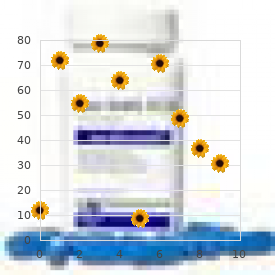
Discount 100 mg cefixime free shipping
The likely sequence of events resulting in bacteria that causes pneumonia 100mg cefixime with mastercard the technology of these alloantibodyproducing cells is that naive B lymphocytes 382 Chapter 17 � Transplantation Immunology A Blood vessel Complement activation antibiotics for uti in diabetics purchase cefixime 100 mg line, endothelial injury antibiotics beginning with c effective 100mg cefixime, irritation and thrombosis Circulating alloantigenspecific antibody Endothelial cell Alloantigen antibiotic abuse buy generic cefixime 100 mg online. A, In hyperacute rejection, preformed antibodies reactive with vascular endothelium activate complement and trigger fast intravascular thrombosis and necrosis of the vessel wall. B, Hyperacute rejection of a kidney allograft with endothelial damage, platelet and thrombin thrombi, and early neutrophil infiltration in a glomerulus. Hyperacute rejection brought on by pure antibodies, specific for a wide range of antigens that differ amongst species, is a major barrier to xenotransplan tation and limits the use of animal organs for human transplantation. Such antibodies generally arise because of previous publicity to alloantigens by way of blood transfusion, earlier transplantation, or multiple pregnancies. If the level of these alloreactive antibodies is low, hyperacute rejection may develop slowly, throughout a quantity of days, but the onset remains to be sooner than that typical for acute rejection. One attainable mechanism of this resistance to hyperacute rejection is increased expression of comple ment regulatory proteins on graft endothelial cells, a useful adaptation of the tissue called lodging. Acute Rejection Acute rejection is a means of damage to the graft parenchyma and blood vessels mediated by alloreactive T cells and antibodies. Before fashionable immunosuppression, acute rejection would typically begin several days to a couple of weeks after transplantation. The time of onset of acute rejection displays the time wanted to generate alloreactive effector T cells and antibodies in response to the graft. In current scientific apply, episodes of acute rejection may happen at a lot later instances, even years after transplanta tion, if immunosuppression is reduced for any variety of reasons. Although the patterns of acute rejection are divided into mobile (mediated by T cells) and humoral (mediated by antibodies), each usually coexist in an organ present process acute rejection. B, Acute mobile rejection of a kidney with inflammatory cells in the connective tissue across the tubules and between epithelial cells of the tubules. C, Inflammation of a blood vessel (vasculitis) in acute mobile rejection, with inflammatory cells damaging endothelium. In kidney allografts, the infiltrates could contain the tubules (called tubulitis), with related tubular necrosis, and blood vessels (called endotheliitis), with necrosis of the partitions of capillaries and small arteries. The binding of the alloantibodies to the endothelial cell surface triggers local complement activation, which causes lysis of the cells, recruitment and activation of neutrophils, and thrombus formation. In addition, alloantibody binding to the endothelial floor might directly alter endothelial perform by inducing intracel lular alerts that improve surface expression of proin flammatory and procoagulant molecules. A, Alloreactive antibodies shaped after engraftment might contribute to parenchymal and vascular damage. B, Acute antibody-mediated rejection of a kidney allograft with inflammatory cells in peritubular capillaries. C, Complement C4d deposition in capillaries in acute antibody-mediated rejection, revealed by immunohistochemistry as brown staining. Since 1990, 1year survival of kidney allografts has been higher than 90%, but the 10year survival has remained approximately 60% despite advances in immunosuppressive therapy. Chronic rejection develops insidiously during months or years and should or may not be preceded by clinically acknowledged episodes of acute rejection. Chronic rejection of different transplanted organs is associated with distinct pathologic changes. In the kidney and heart, continual rejection ends in vascular occlusion and interstitial fibrosis. Lung transplants present process continual rejection show thickened small airways (called bronchiolitis obliterans), and liver transplants show fibrotic and nonfunctional bile ducts. Graft vasculopathy is incessantly seen in failed cardiac and renal allografts and can develop in any vascularized organ transplant within 6 months to a year after transplantation. As the arterial lesions of graft arteriosclerosis progress, blood flow to the graft paren chyma is compromised, and the parenchyma is slowly changed by nonfunctioning fibrous tissue. The interstitial fibrosis seen in persistent rejection may also be a restore response to parenchymal cell damage brought on by repeated bouts of acute antibodymediated or cellular rejection, perioperative ischemia, toxic effects of immunosuppres sive medicine, and even chronic viral infections. Chronic rejection results in congestive heart failure or arrhythmias in cardiac transplant sufferers or loss of glomerular and tubular operate and renal failure in kidney transplant sufferers. The strategies used in medical practice and in experimental models to avoid or to delay rejection are common immunosuppression and minimizing the power of the specific allogeneic response.
References
- Porcel JM. Establishing a diagnosis of pleural effusion due to heart failure. Respirology 2009;14(4):471-3.
- Kellie SJ, Boyce H, Dunkel IJ, et al. Primary chemotherapy for intracranial nongerminomatous germ cell tumors: results of the second international CNS germ cell study group protocol. J Clin Oncol 2004;22(5):846-853.
- Zantut LF, Ivatury RR, Smith RS, et al: Diagnostic and therapeutic laparoscopy for penetrating abdominal trauma: A multicenter experience. J Trauma 42:825; discussion 829, 1997.
- Felip E, Rosell R, Maestre JA, et al. Preoperative chemotherapy plus surgery versus surgery plus adjuvant chemotherapy versus surgery alone in early-stage non-small-cell lung cancer. J Clin Oncol 2010;28(19):3138- 3145.
- Hart S, Skinner EC, Meyerowitz BE, et al: Quality of life after radical cystectomy for bladder cancer in patients with an ileal conduit, cutaneous or urethral Kock pouch, J Urol 162(1):77n81, 1999.

